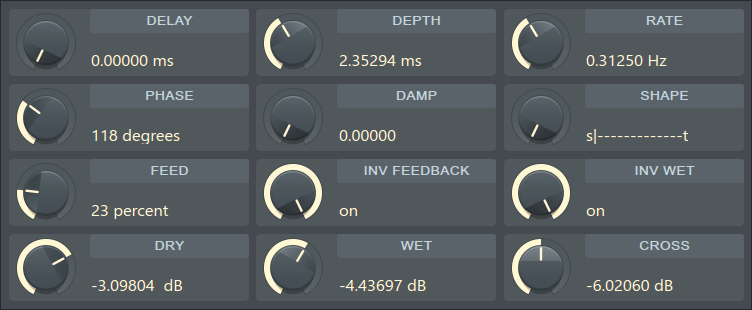MIXING & EFFECTS
Fruity Flanger
Flanging is a form of phase cancellation created by combining multiple, variously delayed copies of the input sound.
Related plugin: Fruity Flangus.

Parameters
- Delay - Sets the minimum delay between the flanger voices. The flanger delay will be swept between delay and delay+depth. Range: 0 to 20 milliseconds. For 'deep' flanger effect, set this parameter to low values.
- Depth - Controls the flanger delay modulation. The flanger delay will be swept between delay and delay+depth. If this value is zero, the flanger will remain 'static' as the delay modulation will stay constant. Setting the 'Depth' to higher values will create heavier modulation.
- Rate - The rate at which the flanger is modulated. Range: 0 to 5 Hz.
- Phase - Use this control to widen the stereo image. Range: 0 to 360 degrees. If set to 0, the LFO on the left and right channels will be in perfect synchronization. At 180 degrees the left and right channel will be 100% out of phase. This means that the left channel will reach its maximum when the right channel is at minimum. Try setting 10 degrees for subtle stereo enhancement.
- Damp - Use this parameter to attenuate the high frequencies of the processed output. Range: 0 (no filtering) to 1 (full filtering - no output).
- Shape - Determines the shape of the LFO. Range: smooth transition between sine to triangle LFO. A sine LFO will produce smoother transitions, while a triangle LFO will result in more constant pitch-shifting. While subtle, this parameter can help you get just the right sound.
- Feed - Sets the feedback amount. Range: 0 to 100 %. Set to high values to make the flanger 'whistle'. Try high settings with heavy filtering (for example 99% feedback + the filter at 0.95) for special effects.
- Invert Feedback / Invert Wet - These two switches invert the processed (wet) and feedback signal. Range: on and off. Mixing a signal with an inverted version of itself creates the known flanger effect. When both are off the sound is more like a chorus than a flanger. While Invert Wet will directly change the flanger/chorus sound, the Invert Feedback has a less dramatic effect, but can be used to change the sound timbre.
- Dry / Wet / Cross - These three knobs determine the output mixture. Range: -inf (silent) to 0dB. Dry is the original signal, wet is the effected signal and cross is a left-right inverted version of the wet signal.
Plugin Credits: Smart Electronix